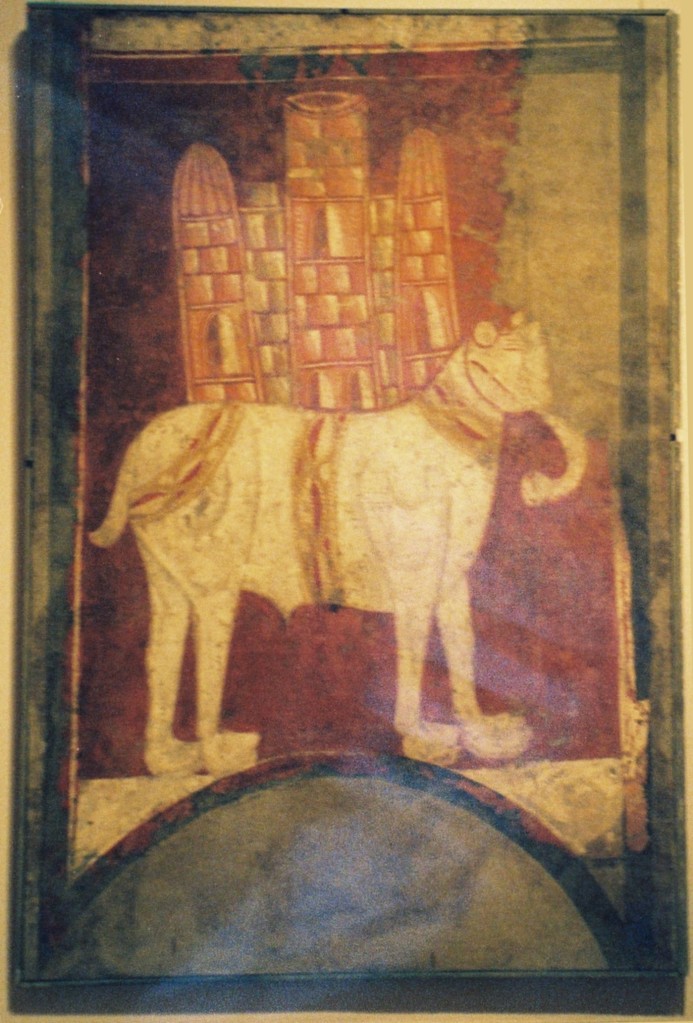The Last Elephant Charge in History? July 25, 2010
Author: Beach Combing | in : Ancient, Medieval, Modern , trackback
Beachcombing has had several very useful emails from readers on the last cavalry charge in history. So many useful emails, indeed, that he has decided to risk repetition and ask a parallel yet no less beguiling question – ‘when was the last elephant charge in history?’
Elephants, after all, were the tanks of the ancient and medieval world. Typically trained to carry men in small towers – as many as 14 – they cast terror into opposing armies, especially among warriors (or horses) that had never seen this beast before.
As only the most aggressive were employed they were consummate warriors, not just carrying soldiers to the enemy but personally wreaking havoc on the foe and on opposing fortifications. They could survive naphtha grenades, arrows – burning or otherwise – and even multiple musket shots. Then there was their fury: ‘One of the elephants, lifting Ilak Khan’s standard-bearer in his trunk, hurled him into the air and then catching him on his steel-clad tusks, cut the wretch in two, while others [elephants] threw down riders from their horses and trampled them to death.’ (Nossov, 39).
Yikes.
Elephants never entirely caught on in the armies of the old, antique Mediterranean. Hannibal, for example, had only thirty seven with him when he crossed the Alps. The largest eastern elephant army that Beachcombing has found reference to was an extraordinary nine thousand strong (including pack animals?). These creatures did though appear, from time to time, in the armies of Syria, Egypt, Carthage and latterly those of Rome.
The last reference that Beachcombing has come across to elephants being used by a Mediterranean army was in the force of that all too Roman idiot Didius Julianus (obit 193 AD), who brought some almost untrained elephants – possibly drafted from a circus – to protect Rome in the year of his death.
The Romans, however, did face elephants in the field again as Persia had elephants from India and employed 700 – remember Hannibal’s 37? – in the Persian-Roman war of 227. There were then, for several centuries afterwards, Roman-Persian and Byzantine-Persian battles where the Romans had to fight off elephants .
A good rule seems to be that the further to the east you go the longer elephant warriors survived. The Indians continued to use elephants on the battlefield into the eighteenth century against the Brits. Beachcombing actually knows of one reference in the Indian mutiny (1857) when that old reprobate/hero Nana Sahib was spotted riding towards the British on top of an elephant. That is not, of course, the same thing as actually doing battle from an elephant. Beachcombing suspects that Nana had far too much sense to attempt that.
In south-east Asia the last references come from the nineteenth century. The last reference, indeed, from anywhere in the world that Beachcombing has been able to find was a battle between the French and the Vietnamese in 1885, when French infantry fled before the beasts of the Nguyen Emperor. The elephants were only driven back with much effort by imperial rifles.
The Siamese continued to use elephants till the end of the nineteenth century as canon carriers. But here we can no longer talk of ‘charges’ as the elephants stood at a distance while artillery, mounted on their backs, was fired.
Elephants, of course, were then used extensively in the twentieth century as beasts of burden in wars, most tragically perhaps in Vietnam, where US planes and helicopters killed columns of ‘red’ elephants.
After all, an elephant could survive hundreds of arrows and tens of musket balls but mounted machine guns, napalm and vulcans were just too much for even the bravest pachyderm.
May the elephants of battle sleep in peace!
Beachcombing thought that the latest cavalry charge would be in the 1950s or the 1960s, but he was about half a century too early. Does anyone know of any elephant charge in the twentieth century – perhaps improvised: particularly given that so many elephants were at the front helping shift heavy objects? drbeachcombingATyahooDOTcom
***
1st Sep: John Kistler author of the brilliant War Elephants wrote to Beachcombing over Beachcombing’s unwise speculations about a charge c. 1943. ‘All the elephants used in WW2 were logging elephants and not prepared to charge at gunfire, they would run and hide, sensibly, under fire. Actually the Burmese rebels still use elephants but no charges, just for riding and cargo. If you want to count fake elephant charges, I believe Benito Mussolini’s son made a movie about the glorious Roman Italian empire of old called Scipio, where Scipio defeated Hannibal. In the movie he actually has a dozen or more elephants charge, but he also has a few elephants truly speared to death to make the movie realistic. So it is a charge to their deaths actually, for a film.’ Beachcombing is tracking down this film – Scipio Africanus (1937) – and will offer a review for next year’s Elephant Week (if he manages to keep on blogging for that long). Thanks to John!



